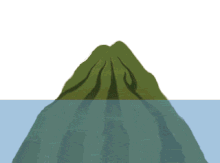Coral island

Acoral islandis a type ofislandformed fromcoraldetritusand associated organic material.[1]It occurs in tropical and sub-tropical areas, typically as part of acoral reefwhich has grown to cover a far larger area under the sea. The termlow islandcan be used to distinguish such islands fromhigh islands,which are formed through volcanic action.[2]Low islands are formed as a result ofsedimentationupon acoral reefor of theupliftingof such islands.
Ecosystem[edit]

Coral reefs are some of the oldest ecosystems on the planet, over geological time, they form massive reefs oflimestone.The reef environment supports more plant and animal species than any other habitat.[3][4]Coral reefs are vital for life in multiple aspects some of which include structure, ecology, andnutrient cycleswhich all supportbiodiversityin the reefs.
Coral reefs build massivecalcareousskeletons that serve as homes for animals such as fish hiding inside the crooks and crannies of the reef and barnacles attaching themselves directly to the coral's structure. The structures also help plants that need the sun tophotosynthesize,by lifting the plants to the ocean's surface where the sunlight can penetrate the water. The structures also create calm zones in the ocean providing a place for fish and plant species to thrive.
Over geological time a reef may reach the surface and can become a coral island, where it begins a whole new ecosystem for land-based creatures.[5]
Formation[edit]

A coral island begins as avolcanic islandover ahot spot.As the volcano emerges from the sea, afringing reefgrows on the outskirt of the volcano. The volcano eventually moves off the hot spot by means ofplate tectonics.Once this occurs, the volcano can no longer keep up with the waveerosionand undergoessubsidence.
Once the island is submerged, the coral must keep growing to stay in theepipelagic zone.This causes the coral to grow into anatollwith a shallowlagoonin the middle. The lagoon undergoesaccretionand creates an island completely made ofcarbonatematerials. The process is later enhanced with the remains of plant life which grows on the island.[6]
Low vs. high island[edit]
The term "low island" refers to geologic origin rather than a strict classification of height. Some low islands, such asBanaba,Makatea,Nauru,andNiue,rise several hundred feet abovesea level,while numerous high islands (those of volcanic origin) rise a few feet above sea level, often classified as "rocks".Low islands ring thelagoonsofatolls.The two types of islands are often found in proximity to each other. This is especially the case among theislands of the South Pacific Ocean,where low islands are found on the fringing reefs that surround most high islands.[citation needed]
Distribution[edit]
Most of the world's coral islands are in thePacific Ocean,but they are also found in theAtlanticandIndian Oceans.The AmericanterritoriesofJarvis,BakerandHowland Islandsare clear examples of coral islands in the Pacific. Atolls in the Atlantic are found in Colombia'sArchipelago of San Andrés, Providencia and Santa Catalina.TheLakshadweep Islandsunion territoryofIndiais a group of 39 coral islands, along with some minorisletsandbanks.Some of theislands belonging toKiribatiare considered coral islands. TheMaldivesconsist of coral islands.St. Martin's Islandis an 8 km2(3.1 sq mi) coral island located inBangladesh.Coral islands are located nearPattayaandKo Samui,Thailand.[7]
Ecology[edit]

Coral is important for biodiversity and the growth of fish populations, so maintaining coral reefs is important. Many coral islands are small with low elevation above sea level. Thus they are at threat from storms andrising sea levels.Through chemical and physical changes humans can cause significant harm to reef systems and slow the creation of coral island chains.[5]
Coral reefs are threatened by numerousanthropogenicimpacts, some of which have already had major effects worldwide.[8]Reefs grow in shallow, warm, nutrient-poor waters where they are not outcompeted byphytoplankton.By adding fertilizers into the water runoff, phytoplankton populations can explode and choke out coral reef systems. Adding too many sediments can cause a similar problem by blocking out the sun, starving thezooxanthellaethat live on coral causing it to undergo a process known ascoral bleaching.
The ocean's acidity is also a factor. Coral is made of calcium carbonate and is dissolved by carbonic acid. With the increase in carbon dioxide fromcombustion reactionsin the atmosphere through precipitation, carbon dioxide mixes with water and formscarbonic acid,raising the ocean's acidity which slows coral growth.
Although low islands may have fewer potential habitats than high islands, thus lower species diversity, studies of both types of islands inPalaufound that species diversity, at least in the waters around the island, is more affected by island size than by its origin.[9]
Climate and habitability[edit]
Low islands have poor, sandy soil and little fresh water, which makes them difficult to farm. They cannot support human habitation as well as high islands. They are also threatened bysea level risedue toglobal warming.The people that do live on low islands survive mostly by fishing. Low islands usually have anoceanic climate.
-
TheMoruroaatoll, composed oflow islandson the reef encircling a central lagoon
See also[edit]
References[edit]
- ^"coral island".Encyclopædia Britannica.Retrieved2012-12-26.
- ^Murphy, Raymond E. (July 1949). "'High' and 'Low' Islands in the Eastern Carolines ".Geographical Review.39(3).doi:10.2307/210643.JSTOR210643.
- ^Barnes, R.S.K.; Mann, K.H. (1991).Fundamentals of Aquatic Ecology.Blackwell Publishing. pp. 217–227.ISBN978-0-632-02983-9.
- ^Fuchs. T (2013)."Effects of Coral Reef Complexity on Invertebrate Biodiversity".Immediate Science Ecology Publishing:1–10. Archived fromthe originalon April 2, 2015.
- ^abHeatwole, Harold (1981).A Coral IslandL The story of One Tree Island.Australia: William Collins. p. 130.ISBN978-0002164429.
- ^Erickson, Jon (2003).Marine Geology: Exploring New Frontiers of the Ocean.United States: Facts on File, Inc. pp.126.ISBN978-0816048748.
- ^Andréfouët, Serge; Guzman, Hector M. (2005-03-01). "Coral reef distribution, status and geomorphology–biodiversity relationship in Kuna Yala (San Blas) archipelago, Caribbean Panama".Coral Reefs.24(1): 31–42.doi:10.1007/s00338-004-0444-4.ISSN0722-4028.S2CID11831104.
- ^SEBENS, KENNETH P. (February 1994)."Biodiversity of Coral Reefs: What are We Losing and Why?".American Zoologist.34(1): 115–133.doi:10.1093/icb/34.1.115.ISSN0003-1569.
- ^Donaldson, Terry J. (2002)."High Islands Versus Low Islands: A Comparison of Fish Faunal Composition of the Palau Islands".Environmental Biology of Fishes.65(2): 241–248.Bibcode:2002EnvBF..65..241D.doi:10.1023/A:1020067931910.ISSN0378-1909.
External links[edit]
- Micronesian culture: High island and low island culturesat Britannica.com.Retrieved 2011-09-22.


